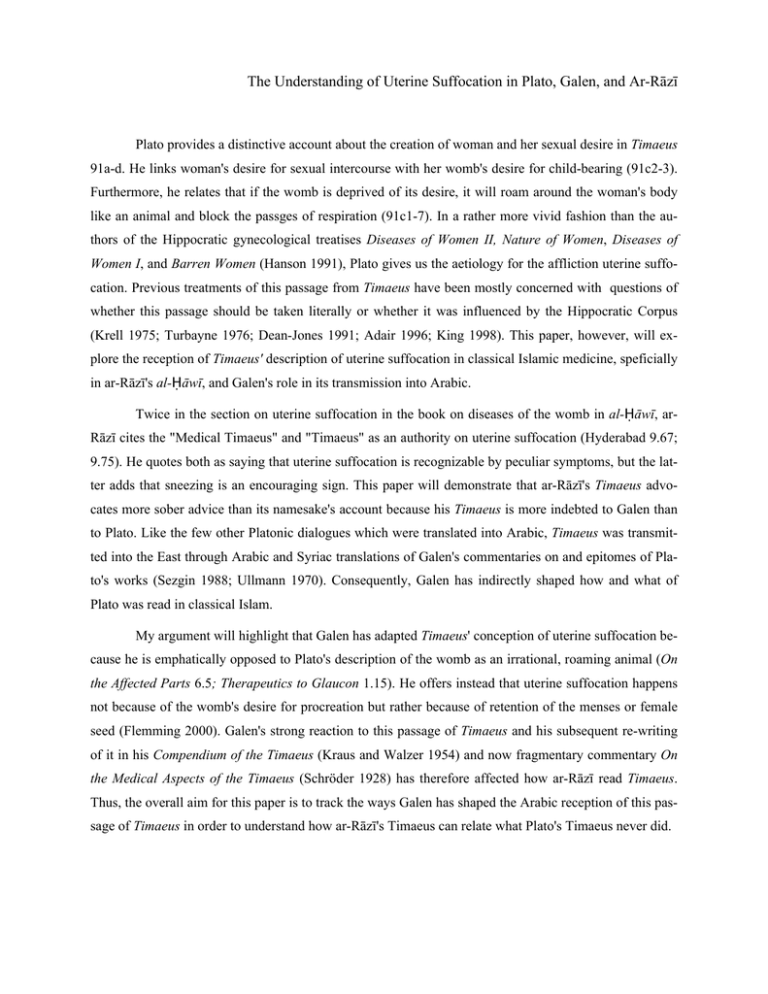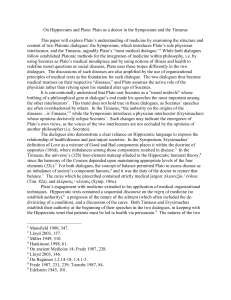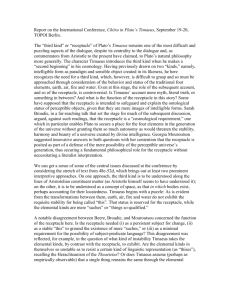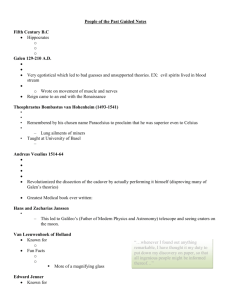
The Understanding of Uterine Suffocation in Plato, Galen, and Ar-Rāzī
Plato provides a distinctive account about the creation of woman and her sexual desire in Timaeus
91a-d. He links woman's desire for sexual intercourse with her womb's desire for child-bearing (91c2-3).
Furthermore, he relates that if the womb is deprived of its desire, it will roam around the woman's body
like an animal and block the passges of respiration (91c1-7). In a rather more vivid fashion than the authors of the Hippocratic gynecological treatises Diseases of Women II, Nature of Women, Diseases of
Women I, and Barren Women (Hanson 1991), Plato gives us the aetiology for the affliction uterine suffocation. Previous treatments of this passage from Timaeus have been mostly concerned with questions of
whether this passage should be taken literally or whether it was influenced by the Hippocratic Corpus
(Krell 1975; Turbayne 1976; Dean-Jones 1991; Adair 1996; King 1998). This paper, however, will explore the reception of Timaeus' description of uterine suffocation in classical Islamic medicine, speficially
in ar-Rāzī's al-Ḥāwī, and Galen's role in its transmission into Arabic.
Twice in the section on uterine suffocation in the book on diseases of the womb in al-Ḥāwī, arRāzī cites the "Medical Timaeus" and "Timaeus" as an authority on uterine suffocation (Hyderabad 9.67;
9.75). He quotes both as saying that uterine suffocation is recognizable by peculiar symptoms, but the latter adds that sneezing is an encouraging sign. This paper will demonstrate that ar-Rāzī's Timaeus advocates more sober advice than its namesake's account because his Timaeus is more indebted to Galen than
to Plato. Like the few other Platonic dialogues which were translated into Arabic, Timaeus was transmitted into the East through Arabic and Syriac translations of Galen's commentaries on and epitomes of Plato's works (Sezgin 1988; Ullmann 1970). Consequently, Galen has indirectly shaped how and what of
Plato was read in classical Islam.
My argument will highlight that Galen has adapted Timaeus' conception of uterine suffocation because he is emphatically opposed to Plato's description of the womb as an irrational, roaming animal (On
the Affected Parts 6.5; Therapeutics to Glaucon 1.15). He offers instead that uterine suffocation happens
not because of the womb's desire for procreation but rather because of retention of the menses or female
seed (Flemming 2000). Galen's strong reaction to this passage of Timaeus and his subsequent re-writing
of it in his Compendium of the Timaeus (Kraus and Walzer 1954) and now fragmentary commentary On
the Medical Aspects of the Timaeus (Schröder 1928) has therefore affected how ar-Rāzī read Timaeus.
Thus, the overall aim for this paper is to track the ways Galen has shaped the Arabic reception of this passage of Timaeus in order to understand how ar-Rāzī's Timaeus can relate what Plato's Timaeus never did.
Bibliography:
Primary Texts:
Ar-Rāzī, Abū Bakr Muhammad ibn Zakarīyā. Kitāb al-Ḥāwī fī aṭ-ṭibb. Volume 9 (1955-7).
Hyderabad: Osmania Oriental Publications Bureau, Osmania University.
Galen. Compendium Timaei Platonis, Aliorumque Dialogorum Synopsis quae Extant Fragmenta. P.
Kraus and R. Walzer (Eds.). In Plato Arabus, Volume I (1951). London: Warburg Institute.
__________. In Platonis Timaeum: Commentarii Fragmenta. H. O. Schröder and P. Kahle (Eds.). In
CMG Supplement I (1928). Leipzig and Berlin: Teubner.
Plato. Timaeus. J. Burnet (Ed.). Volume 4 (1978). Oxford: Oxford University Press.
Secondary Texts:
Adair, M. J. (1995-1996). Plato's View on the Wandering Uterus. The Classical Journal, 91.2,
153-163.
Dean-Jones, L. (1991). The Cultural Construct of the Female Body in Classical Greek Science. In S.
Pomeroy (Ed.), Women's History and Ancient History (pp. 111-137). Chapel Hill and London:
University of North Carolina Press.
Flemming, R. (2000). Medicine and the Making of Roman Women: Gender, Nature, and Authority from
Celsus to Galen. Oxford: Oxford University Press.
Hanson, A. E. (1991). Continuity and Change: Three Case Studies in Hippocratic Gynecological Therapy
and Theory. In S. Pomeroy (Ed.), Women's History and Ancient History (pp. 73-110). Chapel Hill
and London: University of North Carolina Press.
King, H. (1998). Hippocrates' Woman: Reading the Female Body in Ancient Greece. London and New
York: Routledge Press.
Krell, D. F. (1975). Female Parts in Timaeus. Arion, 2, 400-421.
Sezgin, F. (1967-). Plato. Geschichte des arabischen Schrifttums, Volume 3. (pp.48-49). Frankfurt am
Main: Institut für Geschichte der Arabisch-Islamischen Wissenschaften.
Turbayne, C. (1976). The Fantastic Appendix: the Procreation Model of the Timaeus. Paideia, Special
Issue, 125-140.
Ullmann, M. (1970). Περί τῶν ἐν τῷ Πλάτωνος Τιµαίῳ ἰατρικῶς εἰρηµένων. Die Medizin im Islam:
Handbuch der Orientalistik, Volume I (pp. 64). Leiden: E. J. Brill.





